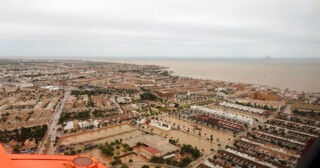The Deluge
Fiona Pitt-Kethley
Southern Spain has suffered a catastrophic storm that will have repercussions for years to come. As I write there are seven people dead who were caught in flash floods. Several hundred have been rescued. Some were given temporary shelter in sports centres. A special army unit was on stand-by and the prime minister has visited some of the worst affected spots. About 1500 farm animals died in the region of Murcia. The sea spat out a thousand dead tuna from a fish farm, and beaches on La Manga had to be closed till the rotting corpses were removed. They had already left an oily film on the sea.
I have lived in Spain for 17 years and had a few experiences of the gota fría, the ‘cold drop’: seriously heavy rain at the beginning of autumn. Buildings spring leaks as the rain is so severe it can force itself in through a pinhole in the grouting between tiles. Flash floods cause the odd death for those unlucky enough to be in the wrong place at the wrong time. Public information generally advises you not to drive unless you absolutely have to.
The gota fría is also known as DANA, ‘depresión aislada en niveles altos’ (‘isolated depression at high levels’). This year it was a memorably horrible experience which stopped and started across three days and hit its worst level on Friday the 13th. The nights were the most frightening. To stop my house flooding I had to go outside several times to clear a small drain on the terrace which blocks easily if bits of stick and soil get caught in it. While putting my arm down the drain I was faced with a strange sheet lightning display that strobed at high speed. It was as if I were in a 3D version of an El Greco painting. The thunder wasn’t the usual big bangs but more of a persistent drumming, howling and groaning. As the lightning flashed in all directions, I felt as if I were trapped in a giant drum or centrifuge. After each drain clearance I slept fitfully with my bed full of rescued feral cats who were slightly more friendly than usual given the extreme circumstances. After two nights of this and intermittent rain by day the storm culminated in hailstones the size of golf balls. I wondered if there would be a rain of frogs next.
At intervals during the day I looked at news pictures of places I knew that had been severely damaged. Others were threatened by a full reservoir behind the dam at Santomera and the overflowing of the Rio Segura. Most gota fría rain subsides quickly but not this time. Apart from climate change there are local issues involved. Land has been built on that should have been left bare. In other places drainage has been ill-planned or ill-maintained. On the coast, the modern beaches have been swept away as the Mar Menor dashed against the promontories and pavements. The pictures of the coastline recall those of several decades ago before the building boom.
The Mar Menor is changing rapidly for the worse. Some ecologists already call it dead. At Lo Pagán and San Pedro, at the northern end of the lagoon, there are bathing facilities similar to those of the Dead Sea and a strip of land leading out to salt pans and flamingos. Most of this land comes under the aegis of San Pedro and San Javier. The southern end of the Mar Menor is far more polluted. It is managed, or more often ignored, by the city I live in, Cartagena. Many promises have been made but little has been done. I recently received an e-booklet, produced by the region, showing all the species in the Mar Menor. It all looks lovely, but few of these are left in any significant quantity. Most of the sea horses have been eliminated either by pollution or by the former custom of catching them and drying them out to sell to tourists.
There are some mining residues in the Mar Menor, but by far the biggest problems have come from agriculture and modern building. There are areas full of green algae fed by nitrate-rich run-off. The jellyfish population increased, and other species died. The lagoon is currently coughing up dead fish, crabs, shrimps and seahorses.
Every summer I set up a stall selling minerals in a free space outside the concerts of the Cante de las Minas, a Flamenco festival that has taken place for more than fifty years in the former mining town of La Unión. My sales aren’t great, but I meet interesting people. The filmmaker Isabelle Carbonell is currently making a documentary on the Mar Menor. We spent a day looking round La Unión and Portmán. I have lent her my as yet unpublished book, ‘Washing Amethysts in the Bidet’, about mineral collecting and the history of the area. I hope her film, The Blooming, will go some way to stimulate interest in the Mar Menor before it is too late. And I hope the EU, of which Spain is still a prominent member, will put more money into saving the lagoon.

Comments
On https://www.murciaturistica.es/en/san_javier/ everything still looks wonderful, and indeed, one suspects that there is an element of denial here.
So keep on telling us the bad news. We need it.